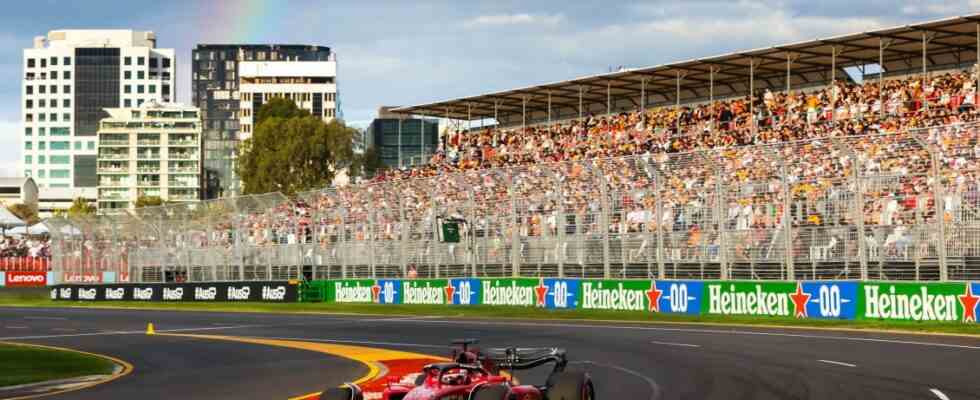There is not much that Stefano Domenicali copied from Bernie Ecclestone. The difference between the Italian, who is at the forefront of Formula 1 today, and the Brit, who used to pull the strings, is already evident in the title. Domenicali, 56, operates as CEO – Ecclestone, now 91, only ever appeared as a zampano. However, the two have one thing in common: they know how to always leave their contractual partners in the dark for the good of the business. Domenicali doesn’t make the whole thing any more charming – but thanks to his tough negotiating tactics, the global boom in Formula 1 is paying off just right.
At the other end of the world, that is in Australia, they have had to wait long enough to be able to join again. Short flashback: It is a Friday the 13th when the race in Melbourne is canceled in March 2020, although the spectators are already at the gates – corona fear. After that, nothing will be the same again, the Australian Grand Prix, which was postponed to autumn 2021, will again become a Covid 19 victim. Formula 1 pulls through two truncated racing years and is also gaining enormous popularity as a result.
After 760 days, she is now back in Melbourne, and for the Australians, but also for many drivers, after two guest appearances in the Middle East, it feels as if the season started with the race on Sunday morning German time (7 a.m., Sky). really starts. Over the weekend, a total of 400,000 spectators spread a party atmosphere in the beach district of St. Kilda. Melbourne also has a lot of catching up to do, the metropolis on Port Philip Bay had to endure 262 days of lockdown, a sad world record. Formula 1 almost becomes a kind of messenger of freedom.
A race in Germany? That could only become an issue again if Porsche or Audi enter Formula 1
For all the sports enthusiasm in the city on the Yarra River, there are also critics of the more than a billion Aussie dollars in taxpayer money that has been invested in racing and the track over the past quarter century. The temporary slope in Albert Park has been made nice since the last guest performance. The track was resurfaced, five corners were redesigned, two were thrown out entirely. More speed, more opportunities to overtake, more risk – and therefore more attractive.
Are classics canceled or do they have to rotate in competition with others? Stefano Domenicali, CEO of Formula 1, knows how to capitalize on the sport’s current boom.
(Photo: Clive Mason/Getty Images)
All over the world they are currently improving the routes, because a merciless cut-throat competition has broken out between the organizers since Formula 1 can no longer save itself from inquiries from rich cities or countries. Next year Qatar and Las Vegas will be fixtures on the World Cup calendar. The racing teams have agreed to a maximum of 25 races per season, this year the provisional record number of 23 should be reached, although Russia was canceled immediately after the start of the Ukraine war. Domenicali is already dreaming of 30 appointments and he’s trying to cleverly gamble up the number.
If the demand for races exceeds the possibilities of the schedule, then selection is made. Each entry is likely to pay significantly higher entry fees than most established Grands Prix, so why forego additional income? In order to shape the new face of the premier class, Domenicali threatens to either delete previous classics or have them rotated. However, there has long been no talk of a race in Hockenheim or on the Nürburgring – who would want or be able to pay for it there. That may only change with the possible entry of Porsche or Audi.
Lewis Hamilton wants a race in South Africa
Lucky for the Formula 1 commitment is that some contracts expire. This creates space or increases the offers. French racing driver Pierre Gasly, whose home race at Le Castellet appears to be in jeopardy despite Emmanuel Macron’s efforts, warns: “No race is safe these days.” The old battle between culture and coal rages on, in which tradition could fall by the wayside. “We have to find a balance between old and new,” demands world champion Max Verstappen, who was allowed to compete at home in Zandvoort for the first time last year: “It’s the most fun to drive on the historic circuits.”
For Sebastian Vettel it is simply “inconceivable” to lose races like Melbourne or Monza, but he also knows: “In the end, Formula 1 is of course always business.” When it comes to balance, seven-time champion Lewis Hamilton thinks much further: if he could wish for a race, it would be in South Africa – which was last on the World Cup calendar in 1993.
Mercedes team boss Toto Wolff is not worried about oversaturation. He looks at the purely economic balance: “For viewers on television in social media, it doesn’t matter where we drive. But on the traditional routes we compete for the local fans. And as we can see in Melbourne – they thank us with a big backdrop.” Melbourne’s contract expires in 2025, and the Australians would like to extend it immediately, preferably by ten years.

